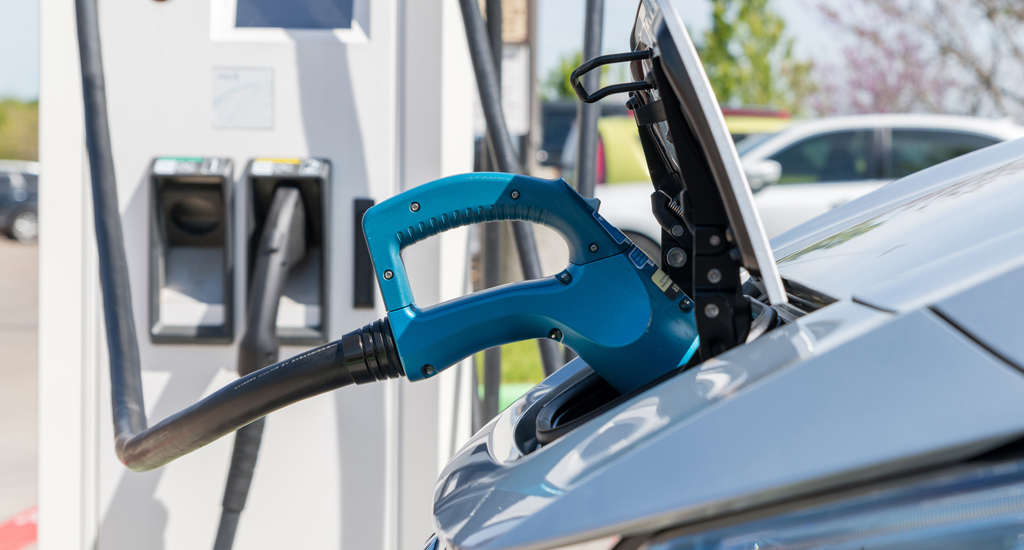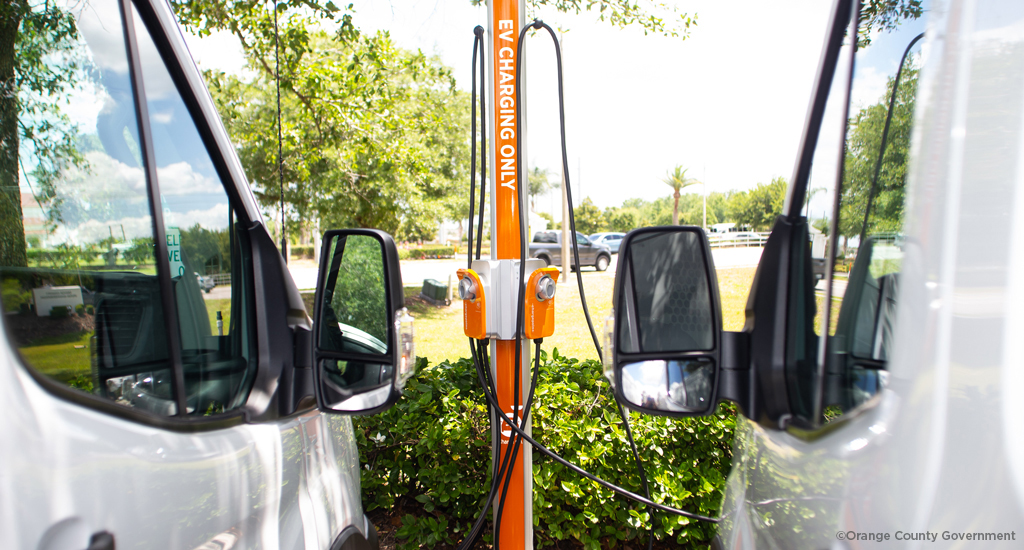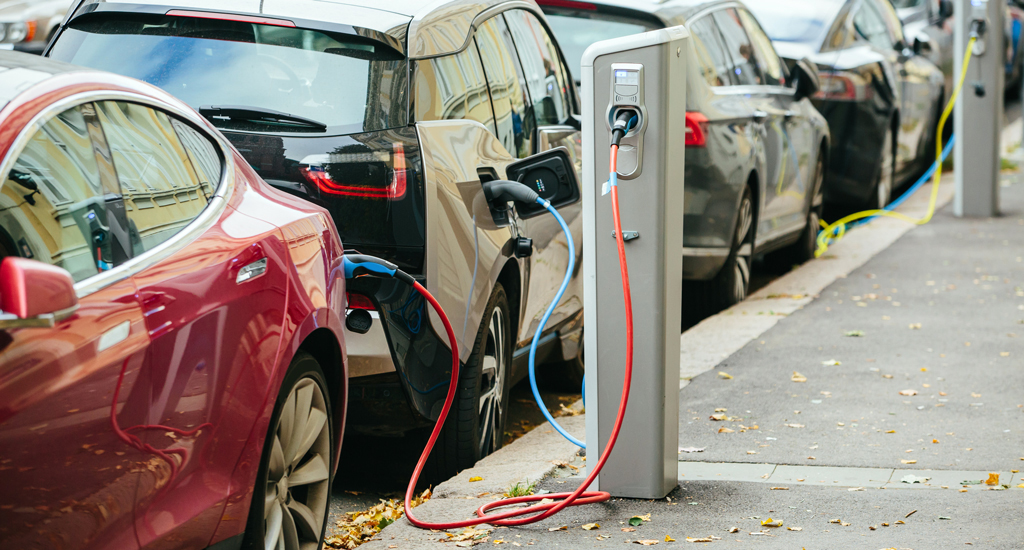Forward-thinking insights focused on a more sustainable tomorrow.
Clean Energy Revolution: Electric Vehicles Transform the Future of Mobility
In response to climate change, we are experiencing a modern day global energy transformation and clean energy revolution. While the world is still largely dependent on fossil fuels, there is a clear progression toward renewable energy, with a noticeable acceleration in the integration of electric vehicles (EVs).
Demand for EVs is rising to help meet local, state, and federal net zero and decarbonization goals, as well as in response to manufacturer investments, environmental pollution, and health concerns. Greenhouse gas (GHG) emissions are a significant source of air pollution and major contributor to climate change—with transportation generating the largest share at 27 percent. EVs present an immediate opportunity to reduce transportation emissions, contribute to better environmental and human health, and help combat climate change.
The EV transformation, however, is about more than just energy source and mode of transport. Charging facilities will look, feel, and operate differently from existing gas stations. The transition from gas- to electric-powered vehicles is a positive disruptor that will impact many aspects of mobility and infrastructure—as well as the overall architecture, engineering, and construction (AEC) industry.
As this quickly moving transformation continues, questions VHB is exploring and developing solutions for include:
- What is the anticipated timeline for complete transformation of our transportation system from one based on petroleum to one based on electric power?
- What land-use changes will be required to accommodate new infrastructure needs?
- Where will stations be located to provide the most equitable access to EV charging infrastructure?
- How will existing and new facilities integrate charging stations, which—unlike gas stations—do not need to be stand-alone facilities?
- What will become of gas stations that are rendered obsolete over the next decades? How can these assets be repositioned to meet evolving demands?
- What new standards and policies need to be developed to enhance safety and efficiency for active transportation options (e.g., e-bikes and e-scooters) as part of growing urban mobility?
- How will future charging mechanisms (e.g., inductive, wireless charging technology or charging robots) be incorporated into our infrastructure?
Infrastructure Evolution
EV sales in the U.S. are expected to rise, with AutoPacific predicting that EV sales nationally will pass the one million mark in the next two years and hit two million by 2026—more than 10 percent of a healthy year’s total new vehicle sales, compared to less than three percent of sales in 2021. As the demand for EVs accelerates, so does the need for additional EV charging infrastructure. The Infrastructure Investment and Jobs Act (IIJA) has identified $7.5 billion to build EV charging infrastructure nationwide and accelerate the adoption of EVs to address the climate crisis. This presents an opportunity for state and local governments—as well as transportation agencies, land developers, and energy providers—to think about sustainability in a more practical, real-world way as they develop and implement solutions to minimize impacts associated with climate change.
Smart, future-ready communities are intentional about innovative thinking and strategic planning, while leveraging new and existing technologies to create a better tomorrow. As private developers, utilities, institutions, and state and local governments begin to plan for the EV transformation, we must consider where stations will have the most positive and equitable impact, how we can maximize site design to provide a safe and inviting driver experience, and what effect EVs will have on the United States’ power grid—now and into the future.
Strategic Locations
Charging infrastructure is critical to the mass adoption of EVs. However, according to the Department of Energy’s Alternative Fuels Data Center, as of July 2022 there are less than 50,000 public EV charging stations in the U.S. To provide the most convenient, reliable, and equitable access, EV charging stations need to be strategically located. This includes along major highway corridors, near shopping centers, at office buildings, as part of mixed-use developments, as well as within communities at town centers and public parks. As of June 2022, proposed new rules for EV charging stations built with federal dollars include positioning stations every 50 miles along interstates and locating stations no more than one mile from major highways to allow for quick charging.
Personal EV chargers can be installed by single-family homeowners in their garage. However, planning for EV charging infrastructure must consider equitable access for those who reside in different housing. Locating EV charging stations at multifamily housing units incentivizes renters to invest in EVs, which helps to reduce GHG emissions and dependence on fossil fuels, lessen air pollution, and increase positive health outcomes.
Smart communities are intentional about harnessing new and existing technologies to plan for a better tomorrow. EV infrastructure drives future-ready outcomes, with smart communities relying on EV charging stations to power connected and autonomous vehicles and further integrate data, technology, and innovation to improve sustainability and quality of life. As part of smart community initiatives, data and technology can be leveraged to identify gaps in the existing EV charging network and provide equitable access to all, including those in rural, underserved, and disadvantaged communities, and those without access to home charging.
Planning for and placement of infrastructure for charging station locations across the U.S. requires an integrated approach. To help advance deployment of EV charging stations, partnerships are being formed between utility companies, equipment suppliers, private companies, transportation agencies, and federal, state, and local governments. Questions to consider:
- Where will stations have the most equitable impact?
- With the current proposal for EV stations along every 50 miles of major federal highway, what will this mean for communities and how they strategically plan for charging stations?
- Can community charging stations help expand ownership, including for apartment and multifamily dwellers, homeowners without garages, or low-income residents?
- How can we leverage technology and planning best practices to identify the most useful locations?

Learn more about how strategically locating this network of stations along major interstate routes and near shopping centers provides convenient, reliable access for powering vehicles.
User Amenities
Charging stations must provide a safe and inviting driver experience. While pumping gas generally takes only a few minutes, charging EVs requires more time. Mixed-use developments that include dining, shopping, and entertainment or recreation venues offer a variety of driver amenities during charge time. Highways with existing parking stalls and rest area amenities also provide desirable sites for EV charging stations.
Mobility or transit hubs are places that connect people with transportation and other supporting services. Developed with flexibility, placemaking, and access to opportunity in mind, mobility hubs improve access to public transportation and aggregate and improve rider mobility options, including EVs. Sites that include a variety of multimodal and transit connections, including rideshare pick-up and drop-off areas, scooter rentals, and transit-oriented development present attractive options for EV charging infrastructure.
Gas stations, aging retail centers, and other underutilized assets will demand EV charging infrastructure to create better value for owners and customers. Site planning and conceptual design must consider space for parking, amount and type of charging stations, and power supply equipment. Questions to consider include:
- How can we maximize land use and site design?
- Are charging stations near major arterials for convenient access to transportation networks?
- What amenities should be included at sites, where drivers will need to spend time during charging?
- How can we best engage stakeholders and the public to explore desired sites and amenities?

Learn more about how VHB is helping Orange County prepare for influx of EV charging stations.
Power Grid Impacts
BloombergNEF predicts that by 2025 EV sales worldwide will more than quadruple, from 3.1 million in 2020 to 14 million in 2025. By 2040, EVs will represent more than 60 percent of all new car sales worldwide, including nearly 75 percent of new car sales in the U.S. Fleet conversion to electric, for both commercial and personal vehicles, will have a major impact on America’s electric grid network.
While EV-only manufacturing may one day be the norm, building the infrastructure to support this transition is a necessary first step. Having EVs on the road will do no good if the vehicles cannot be charged. Building redundancy and resiliency into the transmission, distribution, and substation infrastructure will be important to accommodate increased capacity needs—and will play a critical role in the power grid’s transition to clean energy.
The availability of electric power, including renewable sources, as well as relationships with energy utilities, will be a key factor to EV charging infrastructure site selection. Longer term, we will need to plan for the next evolution of vehicles, which could include autonomous vehicles and electric vertical take-off and landing (eVTOL) aircraft, as well as wireless charging technology or chargers powered by artificial intelligence. Questions to consider include:
- How many and what types of chargers will be needed?
- What is the timeline for installation?
- Is there available existing infrastructure that can be repurposed?
- How can we leverage data and technology to track charging station usage and forecast future needs?

Learn more about how this plan supports EV policy, use, and infrastructure.
How VHB Can Help
As the energy revolution continues and EV demand becomes widespread across the U.S., public and private clients rely on VHB’s guidance, experience, and local relationships to help plan, permit, and build future-ready infrastructure that supports EV charging stations. Our experience with major infrastructure projects and deep regulatory understanding gives VHB insight into the needs and challenges of implementing EV infrastructure. Our integrated thinking and solutions help guide clients and owners through site identification, evaluation, and selection, as well as design and permitting.
VHB looks forward to developing solutions for EV charging infrastructure as part of smart communities that will help to:
- Integrate data and technology into the built environment,
- Create a convenient and equitable charging network, and
- Improve sustainability and quality of life throughout neighborhoods.
Significant investment in public EV charging is intended to make EVs a more appealing, reliable, and accessible means for Americans to fight climate change, reduce carbon emissions, and decrease our reliance on fossil fuels. Together, we can prioritize the creation of forward-thinking, sustainable, and equitable solutions to accelerate the transition to an electric transportation future.
Learn more about how VHB partners with public and private clients to advance the implementation of EV charging stations and infrastructure along the East Coast. Connect with Energy Market Leader Kris Dramby or Director of Smart Communities Curt Ostrodka to start planning for a cleaner and greener tomorrow.




